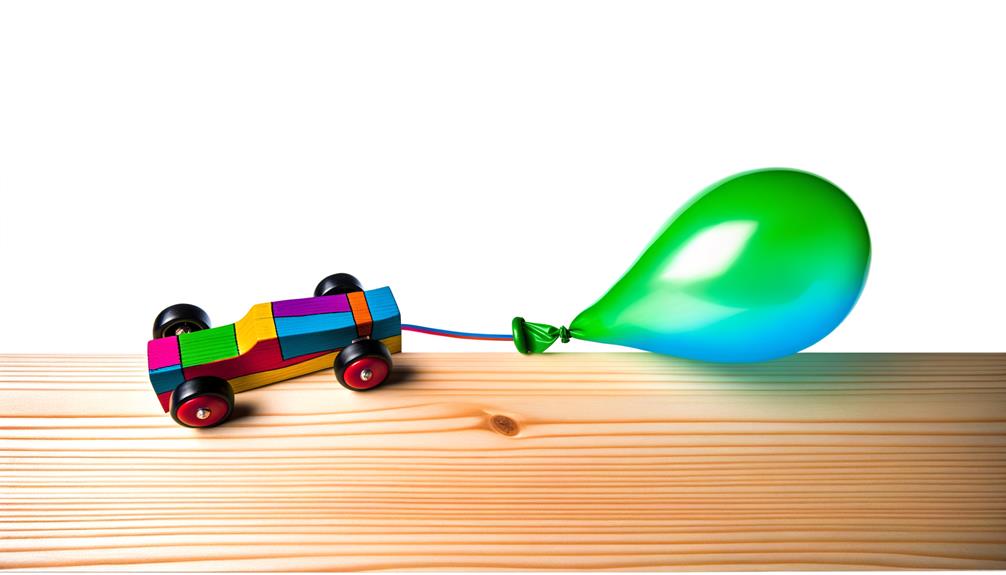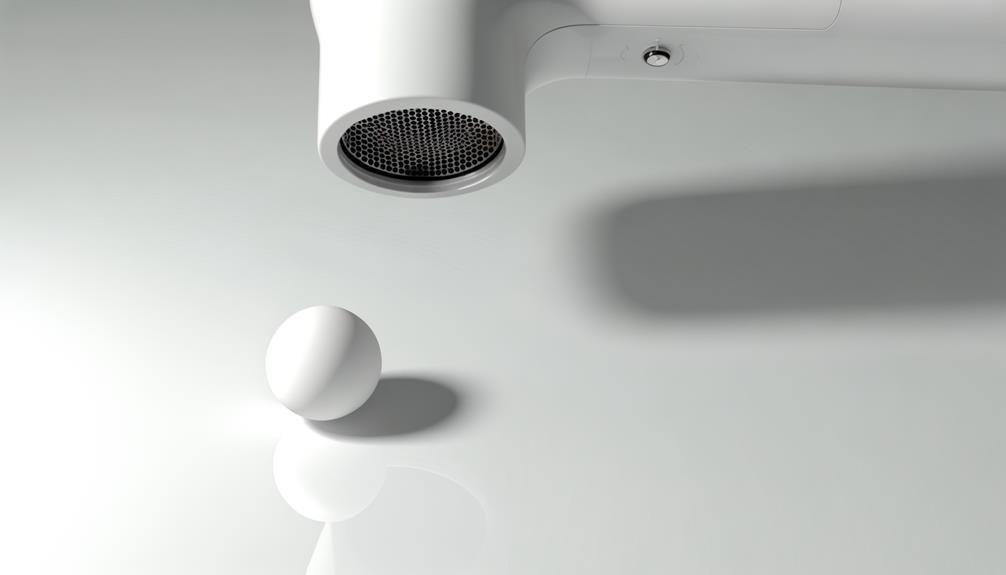Get ready to harness the power of air and amaze your friends with these 7 hands-on science experiments that make the invisible force of air pressure come to life right before your eyes! You'll witness a marshmallow compress inside a bottle, make a cup stick to the table with suction, race balloon-powered cars, suck an egg into a bottle, crush a can with atmospheric pressure, build your own hovercraft, and levitate a ping-pong ball in midair. These engaging activities will spark your curiosity about the fascinating world of air pressure and the science behind everyday phenomena. Let's plunge into and discover more!
The Mighty Marshmallow
Harnessing the power of air pressure, the Mighty Marshmallow experiment is a fun and engaging way to demonstrate this invisible force. You'll need a clear, narrow bottle, a marshmallow, and a straw.
Begin by placing the marshmallow inside the bottle. It should fit snugly about halfway down. Now, insert the straw into the bottle, pushing it until it nearly touches the marshmallow.
Here's where the magic happens: take a deep breath and blow hard into the straw. As you force air into the bottle, you'll see the marshmallow begin to compress and deform. When you stop blowing, the marshmallow will return to its original shape.
This happens because the air pressure inside the bottle increases when you blow, squeezing the marshmallow. When you stop, the pressure equalizes, and the marshmallow expands back to its normal size.
Try experimenting with different amounts of air and observe how the marshmallow reacts. You can even challenge your friends to see who can compress the marshmallow the most!
This simple experiment showcases the incredible power of air pressure and how it can affect objects around us.
Suctioned Cup Surprise
With just a cup and a smooth surface, you can create an astonishing display of air pressure's strength.
Press a cup firmly against a smooth surface, like a tabletop or window, and try to pull it straight off. You'll find it's incredibly difficult, as if the cup is suctioned onto the surface. That's because you've forced most of the air out from under the cup, creating a low-pressure area inside. The higher air pressure outside the cup presses against it, holding it tightly to the surface.
To release the cup, you need to let air back underneath it. Try sliding the cup sideways or lifting one edge slightly. You'll hear a satisfying pop as the air rushes back in, equalizing the pressure and allowing you to remove the cup easily.
This simple experiment demonstrates how differences in air pressure can create powerful forces, like the suction you feel when trying to pull the cup directly off the surface. It's a great way to visualize the invisible power of air pressure at work in your everyday environment.
Balloon-Powered Car Race

Ready, set, go! You're in for an exciting race with balloon-powered cars. In this experiment, you'll harness the power of air pressure to propel your vehicle forward.
To build your racer, you'll need a lightweight cardboard base, drinking straws, tape, and a balloon. Here's how to assemble it:
- Cut a rectangular base from the cardboard and attach the drinking straws as axles.
- Secure the wheels (bottle caps or cardboard circles) to the axles.
- Tape the balloon to the straw on the base, ensuring the opening faces the opposite direction of travel.
Inflate the balloon by blowing air into it, but don't tie it off. Instead, pinch the end closed with your fingers.
Place your car on a flat surface, release the balloon, and watch as the escaping air propels your vehicle forward. Experiment with different balloon sizes, car designs, and surfaces to see how these variables affect your car's speed and distance traveled.
Challenge your friends to a balloon-powered car race and discover who can build the fastest or farthest-traveling vehicle!
Egg-in-a-Bottle Trick
Have you ever wondered if you could fit an egg into a narrow-necked bottle without breaking it? With the Egg-in-a-Bottle Trick, you'll see how air pressure can make the seemingly impossible possible.
First, hard-boil an egg and peel off the shell. Next, place a small piece of lit paper into a glass bottle, quickly followed by the egg on top. As the flame consumes the oxygen inside the bottle, the air pressure decreases. The higher air pressure outside the bottle then pushes the egg inside!
To get the egg out, you'll need to increase the air pressure inside the bottle. Tilt the bottle until the egg plugs the opening. Then, blow hard into the bottle; the egg will pop back out.
This trick works because the bottle's mouth is just slightly smaller than the egg, creating an airtight seal. The changing air pressure does the rest.
Amaze your friends and family with this classic experiment that showcases the incredible power of air pressure!
Atmospheric Pressure Crusher

Crushing a can might seem like a feat of strength, but with the power of atmospheric pressure, you can do it without breaking a sweat! Here's what you'll need:
- An empty aluminum can
- A stovetop or hot plate
- Tongs or oven mitts
First, fill the can with about a tablespoon of water. Place the can on the stovetop or hot plate and turn the heat on high. Wait for the water to boil and steam to escape from the opening.
Using the tongs or oven mitts, quickly flip the can upside down into a bowl of cold water. The sudden change in temperature and the lack of air inside the can will cause the atmospheric pressure to crush the can instantly!
This experiment demonstrates how the pressure of the air around us is strong enough to crush an aluminum can when there's a vacuum inside. The boiling water pushes the air out of the can, and when it's quickly cooled, the water vapor condenses, creating a vacuum. The atmospheric pressure then crushes the can from all sides.
Hovercraft at Home
You can create your own mini hovercraft with just a few household items!
You'll need a CD or DVD, a pop-top lid from a plastic bottle, some superglue, and a balloon.
First, apply superglue to the top of the pop-top lid and stick it onto the center of the CD's shiny side. Make sure it's securely attached.
Next, blow up the balloon and twist the neck to keep the air inside. Stretch the neck of the balloon over the pop-top lid, ensuring a tight seal.
Now, place your hovercraft on a smooth, flat surface and untwist the balloon's neck to release the air.
Watch as your hovercraft glides effortlessly across the surface, carried by the thin layer of air escaping from the balloon! The air creates a cushion between the CD and the surface, reducing friction and allowing the hovercraft to move smoothly.
Experiment with different surfaces and balloon sizes to see how they affect your hovercraft's performance.
This simple project demonstrates how air pressure can be harnessed to create a fun and educational toy.
Bernoulli's Floating Ping-Pong Ball

To demonstrate Bernoulli's Principle, you'll need a ping-pong ball, a straw, and some lung power.
Position the straw vertically about an inch away from the ball, and blow a steady stream of air.
You'll see the ball float in the air stream, seeming to defy gravity!
Bernoulli's Principle Explained
Bernoulli's principle blows us away with its stunning demonstration of air pressure in action. When you blow air across the top of a ping-pong ball, you're decreasing the air pressure above it, while the higher air pressure below the ball pushes it upwards, causing it to levitate in the air stream.
This enthralling phenomenon is explained by Bernoulli's principle, which states that:
- As the velocity of a fluid (like air) increases, its pressure decreases.
- When the velocity of a fluid decreases, its pressure increases.
- The total energy in a steadily flowing fluid remains constant along its path.
In this experiment, the fast-moving air above the ball has lower pressure than the slower-moving air below it, creating a pressure difference that lifts the ball.
By tilting the straw slightly, you can even make the ball appear to defy gravity and hover at an angle!
Bernoulli's principle is a fundamental concept in fluid dynamics, with applications ranging from aerodynamics to the design of wind instruments, making it an essential part of understanding the power of air pressure.
Step-by-Step Experiment Instructions
Let's plunge into this enchanting experiment that brings Bernoulli's principle to life!
You'll need a ping-pong ball, a funnel, and your breath. Begin by placing the ping-pong ball inside the funnel's wide end. Now, hold the funnel vertically, with the narrow end pointing down.
Here's the magical part: blow a steady stream of air straight down into the funnel. As you exhale, you'll witness the ping-pong ball defying gravity and floating in midair!
What's happening? By blowing air through the funnel, you're increasing the air's velocity around the ball. Bernoulli's principle states that as air moves faster, its pressure decreases.
The high-speed air you're blowing creates a low-pressure zone around the ball, while the relatively still air underneath it exerts higher pressure. This pressure difference counteracts gravity, pushing the ball upwards and keeping it suspended in the funnel.
Keep blowing steadily, and marvel at the power of air pressure! With this hands-on experiment, you're not just learning about Bernoulli's principle—you're experiencing it firsthand.
Science comes alive when you can see, feel, and interact with its wonders.
Frequently Asked Questions
What Is Air Pressure and How Does It Work?
You've probably heard of air pressure, but what is it exactly? It's the force exerted by air molecules pushing against a surface. The more molecules there are, the higher the pressure. That's how it works!
How Does Air Pressure Change With Altitude?
As you climb higher, air pressure decreases. There's less air above you, so the weight of the atmosphere pushing down on you is reduced. That's why your ears pop at high altitudes!
What Are the Real-Life Applications of Air Pressure?
You'll find air pressure applications in everyday life, from drinking straws to vacuum cleaners. It's also essential for weather systems, aircraft flight, and scuba diving. Air pressure is all around us, impacting our world.
How Does Air Pressure Affect the Human Body?
Air pressure affects your body in various ways. At high altitudes, lower air pressure makes it harder to breathe. Rapid pressure changes can cause ear pain. Extreme low pressure environments require special suits to survive.
What Instruments Are Used to Measure Air Pressure?
You can measure air pressure using a barometer, which comes in various types like mercury, aneroid, and digital. Altimeters also use air pressure to determine altitude. Weather stations and aircraft rely on these instruments.
Conclusion
You've just explored the incredible power of air through these 7 fun science experiments. From expanding marshmallows to defying gravity with hovercrafts, you've seen firsthand how air pressure can create amazing effects. These hands-on activities have shown you that air, although invisible, is a mighty force to be reckoned with. So, keep experimenting and discovering—who knows what other astonishing things you'll learn about the world around you? The power of science is in your hands!




Leave a Reply